UMass Extension's Landscape Message is an educational newsletter intended to inform and guide Massachusetts Green Industry professionals in the management of our collective landscape. Detailed reports from scouts and Extension specialists on growing conditions, pest activity, and cultural practices for the management of woody ornamentals, trees, and turf are regular features. The following issue has been updated to provide timely management information and the latest regional news and environmental data.
The Landscape Message will be updated once more in April. The next message will be posted on April 22. To receive immediate notification when the next Landscape Message update is posted, be sure to join our e-mail list
To read individual sections of the message, click on the section headings below to expand the content:
Scouting Information by Region
Environmental Data
The following data was collected on or about April 6, 2022. Total accumulated growing degree days (GDD) represent the heating units above a 50° F baseline temperature collected via regional NEWA stations (http://newa.cornell.edu) for the 2022 calendar year. This information is intended for use as a guide for monitoring the developmental stages of pests in your location and planning management strategies accordingly.
|
MA Region/Location |
GDD |
Soil Temp |
Precipitation |
Time/Date of Readings |
|||||
|
3-Week Gain |
2022 Total |
Sun |
Shade |
||||||
|
CAPE |
5 (BE=45) |
11 |
46 |
44 |
2.85 |
12:00 PM 4/6 |
|||
|
SOUTHEAST |
16.5 |
28.5 |
51 |
44 |
2.05 |
3:00 PM 4/6 |
|||
|
NORTH SHORE |
12 |
19 |
46 |
41 |
1.12 |
10:30 AM 4/6 |
|||
|
EAST |
16 |
30 |
51 |
45 |
2.16 |
3:00 PM 4/6 |
|||
|
METRO |
11 |
17 |
44 |
42 |
1.90 |
6:30 AM 4/6 |
|||
|
CENTRAL |
12 |
14 |
42 |
42 |
0.26 |
12:00 PM 4/6 |
|||
|
PIONEER VALLEY |
8.5 |
9.5 |
48 |
43 |
2.37 |
12:00 PM 4/6 |
|||
|
BERKSHIRES |
8 |
8 |
45 |
41 |
2.34 |
7:30 AM 4/6 |
|||
|
AVERAGE |
11 |
17 |
47 |
43 |
1.88 |
_ |
|||
|
* = information not available |
|||||||||
Phenology
| Indicator Plants - Stages of Flowering (BEGIN, BEGIN/FULL, FULL, FULL/END, END) | ||||||||
|---|---|---|---|---|---|---|---|---|
| PLANT NAME (Botanic / Common) | CAPE | S.E. | N.S. | EAST | METRO W. | CENT. | P.V. | BERK. |
|
Magnolia stellata (star Magnolia) |
Begin |
Begin |
Begin |
Begin |
Begin |
Begin |
Begin |
* |
|
Forsythia x intermedia (border Forsythia) |
Full |
Begin |
Begin |
Begin |
Begin |
Begin |
Begin |
* |
|
Pieris japonica (Japanese Pieris) |
Full |
Begin/Full |
Begin/Full |
Begin/Full |
Begin/Full |
Begin |
Begin |
* |
|
Cornus mas (Cornelian cherry dogwood) |
Full/End |
Full |
Full |
Full |
Begin/Full |
Begin/Full |
Begin/Full |
Begin |
|
Acer rubrum (red maple) |
Full |
Full |
Begin/Full |
Full |
Begin/Full |
Begin/Full |
Begin/Full |
Begin |
|
Acer saccharinum (silver maple) |
End |
Full/End |
Full |
Full/End |
Full |
Full |
Full |
Begin |
|
Hamamelis x intermedia (witchhazel hybrids) |
* |
* |
End |
End |
End |
Full/End |
Full/End |
Full/End |
| * = no activity to report/information not available | ||||||||
Regional Notes
Cape Cod Region (Barnstable)
General Conditions: The average temperature during the period from March 16 to April 6 was 44°F with a high of 64°F on March 20 and a low of 19°F on March 29. The mornings of April 3 & 5 had temperatures below 32°F. So far in April daytime highs have been in the 50s and nighttime lows in the 30s. There has been a fairly even number of cloudy, partly cloudy/partly sunny and sunny days during the period. During the period there have been numerous days with precipitation; the weather station in Barnstable measured some precipitation on 10 out of 21 days, albeit some miniscule amounts. The most significant precipitation event was on March 24 & 25 with just under 1.5” of precipitation. Plants seen in bloom include willows (Salix spp.), crocus (Crocus spp.), hellebore or Lenten rose (Helleborus orientalis), daffodil (Narcissus spp.), and glory of the snow (Chionodoxa spp.). Lawns are beginning to green up and lots of perennials are starting to emerge from the ground.
Pests/Problems: Problems seen in the landscape now include winter-injured boxwoods. White pine needle disease can be seen in areas with a lot of white pine (P. strobus). Some needle damage (needle cast) can be seen on pitch pine (P. rigida). Black knot can be seen on many Prunus species, especially black cherry (Prunus serotina). Lichen growth in the canopy of trees is readily visible at this time of year and results in a lot of inquiries. The heavy populations of fruticose lichens found in the crowns of many tree species is often accused of damaging the trees. However, lichens are not plant pests and are often present as a result of access to the resources they require to grow including a surface to grow on, sunlight, and moisture. Widespread areas of dense fruticose lichens in oak canopies is a good indicator of slow growth and thinning canopies as the result of chronic stresses. Locally those stresses include a long history of past insect pests (winter moth, spongy moth, gall wasp, lecanium scale and two lined chestnut borer) as well as climatic stress (the severe/extreme droughts of 2016 & 2020) and potentially pathogens like armillaria and botryosphaeria. Hairy bittercress (Cardamine hirsuta), mouse-ear cress (Arabidopsis thaliana) and fig buttercup (Ficaria verna) are in bloom. The green buds of the invasive shrub honeysuckles are visible.
Southeast Region (Dighton)
General Conditions: Cooler conditions have prevailed, although we're now well into spring. The peepers have just about finished calling for the season; there's only an echo of the chorus at sundown. Lawn grasses are green and turgid. Snowdrop, crocus, winter aconite, and witch hazel have all gone by. In flower now are: Acer rubrum (swamp red maple), A. saccharinum (silver maple), Scilla (prev. Chionodoxa, glory of the snow), Cornus mas (Cornelian cherry), Forsythia x intermedia (border Forsythia), Scilla siberica (Siberian squill), Magnolia stellata 'Centennial' (star Magnolia), Muscari armeniacum (grape Hyacinth), Narcissus spp (daffodil), Salix discolor (pussy willow), S. gracilistyla 'Melanostachys' (black pussy willow), Pieris japonica (Japanese Andromeda), Ulmus americana (American elm). Cabbage white butterflies, bumble bees, various flies and honey bees are active. Norway maple seedlings have germinated. Ospreys are back in force along the river and settled on respective nesting sites. Peach 'Elberta' is showing pink.
Pests/Problems: Some weeds in bloom are Cardamine hirsuta (hairy bittercress), Stellaria media (chickweed) and Taraxacum officinale (dandelion). There is minor turf disruption due to foraging for white grubs. Slugs are active. It's tick season, it's always tick season but it's especially tick season right now.
North Shore (Beverly)
General Conditions: Cooler temperatures continued to persist in the last two weeks of March into the first week of April. The last few days of March were very cold for early spring with low temperatures in the 20s and minimum temperature deeping down to 18˚F on March 29. The average temperature in the last three weeks was 43˚F with a minimum of 18˚F and maximum of 65˚F. Winds have been very strong on some of the days making it feel much colder. Precipitation has been lower than normal for this time of the year. Approximately 1.12 inches of precipitation have been received at Long Hill during the reporting period. Soils are moist but the surface of the soil is dry due to the drying effect of strong dry winds. Woody plants seen in bloom include: red maple (Acer rubrum), Cornelian cherry dogwood (Cornus mas), anise Magnolia (Magnolia salicifolia), Golden Times Forsythia (Forsythia giraldiana), winter honeysuckle (Lonicera x purpusii ‘Winter Beauty’), February Daphne (Daphne mezereum), Winterthur winterhazel (Corylopsis ‘Winterthur’), weeping Forsythia (Forsythia suspensa), Japanese pieris (Pieris japonica), and leatherleaf Mahonia (Mahonia bealei). Non-woody plants seen in bloom include: Hellebores (Helleborus orientalis), Siberian squill (Scilla siberica) and Puschkinia (Puschkinia libanotica), glory of the snow (Chionodoxa spp.), White Tommy crocus (Crocus tommasinianus), daffodil (Narcissus spp.).
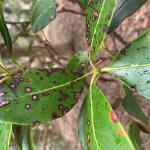
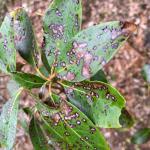 Pests/Problems: Fungal leaf spot of mountain laurel was observed on some shrubs in the landscape. Cultural practices that promote plant vigor such as proper watering, fertilizing, properly timed pruning and raking and removing fallen leaves in the fall can help in the management of the disease. Ticks are active. Take precautions when working outdoors, like applying repellents such as DEET. Do a tick check after working or walking in the woods.
Pests/Problems: Fungal leaf spot of mountain laurel was observed on some shrubs in the landscape. Cultural practices that promote plant vigor such as proper watering, fertilizing, properly timed pruning and raking and removing fallen leaves in the fall can help in the management of the disease. Ticks are active. Take precautions when working outdoors, like applying repellents such as DEET. Do a tick check after working or walking in the woods.
East Region (Boston)
General Conditions: Cool temperatures have prevailed throughout the three week reporting period. Daytime temperatures averaged 55°F with an outlier high of 74°F on March 18, while overnight lows averaged 34°F with extremes of 22°F and 17°F on March 28 and 29 respectively. We are at only 16 GDD’s having received zero GDD’s thus far in April. We received 2.16 inches of precipitation, with 0.72 inches falling March 25 and 26. The landscape is slowly greening up. Spring bulbs continue to add color, Puschkinia scilloides (striped squill) and Scilla siberica (Siberian squill) are flowering. Prunus campanulata ‘Okame’ (Taiwan cherry) is in full bloom. Both early blooming and fragrant; Lonicera purpusii (winter honeysuckle) and Viburnum x bodnantense ‘Charles Lamont’ are flowering. Rhubarb leaves are emerging, as are the underutilized native edible Allium tricoccum (ramps).
Pests/Problems: At only 16 growing degree days there has been minimal pest activity observed in the landscape. Rodent damage is visible on manicured turf. Norway maple (Acer platanoides) seedlings have begun to emerge. Hairy bittercress (Cardamine hirsuta) and chickweed (Stellaria media) are flowering. Frost damage was observed on several early flowering Magnolias after the extreme low temperatures in late March.
Metro West (Acton)
General Conditions: The weather for the month of March could be described as in like a lamb and out like a lion. Cooler temperatures prevailed in the last week of the month with an overnight low of 21°F recorded on the 28th and a daytime high of 34°F, and on the following day, the 29th, an overnight low of 18°F and a daytime high of 38°F were recorded. Also, on the 28th, a small amount of snow fell early in the morning and very lightly blanketed the landscape. If you are not a morning person, you may have completely missed seeing what I hope is the last snow event recorded for the season in this reporting area. The early signs of spring have come and gone including Galanthus spp. (snowdrops) and sap buckets. Now in bloom are Acer rubrum (red maple), Cornus mas (Cornelian cherry dogwood), C. officinalis (Japanese Cornelian cherry), Forsythia spp., Magnolia stellata (star Magnolia) Petasites japonicus (Japanese butterbur), Pieris japonica (Japanese Andromeda), and Symplocarpus foetidus (skunk cabbage). Buds are swelling on several other woody plants including Lindera benzoin (spicebush), Syringa spp. (lilac) and Viburnum spp.
Pests/Problems: April showers bring May flowers and for now, the showers have provided saturated soils, but there has not been sufficient precipitation to set us up for the growing season. According to NOAA, the 20 year monthly average rainfall for March is 3.76” and only 2.21” was recorded this past month. The monthly average rainfall for April is 4.15” and as of the 5th, 0.43” has been recorded. There is a large gap to fill but plenty of days in which to do it.
Central Region (Boylston)
General Conditions: Spring is bursting into bloom in the central region. Many of our early spring bulbs are up on full display, including early daffodils (Narcissus spp.), glory-of-the-snow (Scilla luciliae), winter aconite (Eranthis hyemalis), and snowdrops (Galanthus spp.). This reporting period brought the usual combination of high temperatures (62°F on March 31) and low temperatures (15°F on March 29) that frustrate New Englanders at this time of year.
Pests/Problems: No major pest problems to report at this time. Deer browsing activity is still quite apparent. Until more leafy green forage is available in surrounding natural areas, it’s important to keep up with whatever protective measures you might use to protect susceptible plants from deer browse. Many commercially available repellents are available on the market and repeated applications are often necessary through the winter and early spring months.
Pioneer Valley Region (Amherst)
General Conditions: The spring season is slowly starting to take shape in the Pioneer Valley. Early flowering trees and shrubs (red & silver maples, American elm, Forsythia, Andromeda and Cornelian cherry dogwood) are in or close to full bloom. Among herbaceous plants, snowdrops, crocuses, daffodils and hellebores are starting to emerge or in full bloom. Temperatures have been mostly cool since our first report, hovering in the upper 40s to upper 50s. March closed with some bitterly cold temperatures, as the mercury peaked at only 28°F on 3/28 and dropped down to 16°F during the early morning hours of 3/29. As is expected this time of year, the spring winds have been howling, making conditions feel much colder at times. However, periods of bright sun with very low humidity and the persistent winds have helped to dry out the landscape. While soils are still wet, they aren’t as soggy as they were a few weeks ago in many locations (at the time of writing). Total precipitation for the month of March in South Deerfield was 3.29”, which is slightly less than average. A four day stretch of scattered rain showers (4/6–4/9) will continue to keep soil moisture levels high. The long-term forecast calls for a significant warming, with sustained high temperatures in the upper 60s to 70s, which will surely swell buds and push some plants to start leafing out. Turfgrasses are very slowly starting to green up, but with full sun soil temperatures still below 50°F, it will likely take further warming before we see any dramatic improvement.
Pests/Problems: Scout for spruce spider mites on susceptible conifers (spruce, arborvitae, hemlock, false-cypress), as this cool season mite can cause serious damage when infestations build. Scout for the white pine weevil (Pissodes strobi) on open-grown eastern white pine, Norway spruce and Douglas-fir. Feeding by this native pest can kill the terminal leader, disfiguring the tree. The white pine weevil prefers trees growing in full sun, where conditions are warmer and trees generally have thicker phloem tissues. If you’re planning to apply dinotefuran to control elongate hemlock scale on eastern hemlock or true fir (Abies spp.), wait until the new growth emerges to apply. This will ensure it moves into the current season’s needles. Rosaceous trees and shrubs will soon be leafing out. For apples and crabapples with persistent apple scab infections, removing fallen leaf litter can help to reduce the initial inoculum source. Additionally, leaf litter can be covered with mulch or wood chips to help reduce infection of the newly emerging foliage. Buds are swelling and breaking on Japanese maples in full sun settings. Continue with sanitation pruning on these thin-barked trees before new shoots emerge to remove any lingering cankering pathogens.
Berkshire Region (Great Barrington)
General Conditions: March ended on a high note with a high temperature of 61°F at the Pittsfield Airport on the 31st but just a few days earlier temperatures dipped to 13°F on the mornings of the 28th and 29th. For the month of March, rainfall total as measured at the Pittsfield Airport was 2.77 inches compared to the normal of 3.08 inches. Snowfall for the month was 8.8 inches compared to a norm of 10.00 inches. April has gotten off to temperatures near the norm but there is currently a trend to warmer conditions that are above the norm. As for rain thus far this month, 0.22 inches fell in the early hours of April 1st and 0.25 inches on the 3rd. This rainfall amount was measured at this site in West Stockbridge. A light dusting of snow was observed in shaded spots on the cold misty morning of April 4th. Currently, soil moisture levels are moderate on well drained sites and wet and muddy on sites with heavy soils. Actually, except for muddy soils, conditions are good for planting or transplanting landscape plants. Lawns are greening up and a little bit of turfgrass has begun to grow but not to the point of needing to be mowed. That will change as the forecast is for higher than normal temperatures in the week ahead. Though flower buds are swelling, few woody plants have begun to flower. The usual early spring flowering bulbs are providing color in the landscape. Among these are Grecian windflower (Anemone blanda), winter aconite (Eranthis hyemalis), and Siberian squill (Scilla siberica) which interestingly is considered an invasive species in Minnesota.
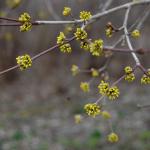
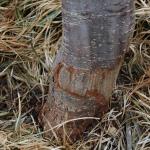 Pests/Problems: Wind issues continued to be a problem through March and into early April. Downing of tree limbs and some trees are common and have resulted in occasional power outages. Though it is early for pest activity, one which was found is adult lily leaf beetle. This appeared on the emerging shoots of lilies. Girdling, primarily by voles, was observed on some young trees and shrubs. This is a reminder that the stems of woody plants should be protected with tree guards after planting. Frost heaving of herbaceous perennials was common in recent weeks due to alternating freeze/thaw cycles as well as a lack of snow cover.
Pests/Problems: Wind issues continued to be a problem through March and into early April. Downing of tree limbs and some trees are common and have resulted in occasional power outages. Though it is early for pest activity, one which was found is adult lily leaf beetle. This appeared on the emerging shoots of lilies. Girdling, primarily by voles, was observed on some young trees and shrubs. This is a reminder that the stems of woody plants should be protected with tree guards after planting. Frost heaving of herbaceous perennials was common in recent weeks due to alternating freeze/thaw cycles as well as a lack of snow cover.
Regional Scouting Credits
- CAPE COD REGION - Russell Norton, Horticulture and Agriculture Educator with Cape Cod Cooperative Extension, reporting from Barnstable.
- SOUTHEAST REGION - Brian McMahon, Arborist, reporting from the Dighton area.
- NORTH SHORE REGION - Geoffrey Njue, Green Industry Specialist, UMass Extension, reporting from the Long Hill Reservation, Beverly.
- EAST REGION - Kit Ganshaw & Sue Pfeiffer, Horticulturists reporting from the Boston area.
- METRO WEST REGION – Julie Coop, Forester, Massachusetts Department of Conservation & Recreation, reporting from Acton.
- CENTRAL REGION - Mark Richardson, Director of Horticulture reporting from Tower Hill Botanic Garden, Boylston.
- PIONEER VALLEY REGION - Nick Brazee, Plant Pathologist, UMass Extension Plant Diagnostic Lab, reporting from Amherst.
- BERKSHIRE REGION - Ron Kujawski, Horticultural Consultant, reporting from Great Barrington.
Woody Ornamentals
Diseases
Recent pests and pathogens of interest seen in the UMass Extension Plant Diagnostic Lab (http://ag.umass.edu/diagnostics):
- Suspected winter injury and Phyllosticta leaf blotch on American holly (Ilex opaca). The tree is seven-years-old and was transplanted two years ago. Site setting includes full sun, with sandy loam soils and drip irrigation. Since last fall, the foliage has developed purple blotches and a marginal burn. Microscopic evaluation suggested fungal activity and after a brief incubation, Phyllosticta was readily sporulating. This fungal pathogen is common on Ilex in landscape settings, especially those suffering from winter injury. While American holly withstands cold winter temperatures very well, some level of winter burn is expected on these plants. Pruning and removal of all leaves with evidence of winter burn is recommended, even if only the margins of the leaf are affected.
- Needle blight of red pine (Pinus resinosa) caused by Septorioides strobi. The tree is roughly 40-years-old and has been present at the site for nearly as long. Over this past winter, 90% of the canopy developed symptoms of needle blight. Specifically, browning at the needle tips and scattered, brown spots and blotches. The tree receives full sun in a well maintained, urban landscape with drip irrigation. The symptomatic needles were infected last season, most likely in June as the needles were developing. However, like many needle blight diseases, symptom development is delayed for many months, often occurring during the winter and late spring. These browning needles will prematurely shed in late spring to early summer.
- Mechanical root injury and winter burn on eastern hemlock (Tsuga canadensis). Several trees, approximately 40-years-old, were planted in a row in a rural residential landscape. The trees sit in a shallow trench between two raised septic systems, with one system on each side. One of the septic systems was installed in spring of 2021 and serious damage was inflicted upon the tree’s root systems. Over this past winter, browning and premature needle shedding developed in the lower canopies. The browning and dieback was consistent with winter injury on hemlock. There was no evidence of HWA or EHS and the dead stems were not harboring any cankering fungi, which can be a problem for stressed hemlocks. Some secondary needle blight pathogens were encountered but they are not suspected of having any major impact on the current condition. Prior to the septic installation, the trees had appeared healthy.
- Tip dieback of Blue Point Chinese junipers (Juniperus chinensis ‘Blue Point’) caused by Pestalotiopsis. A row of upright junipers, approximately 15-years-old, along a property border. The trees receive a mixture of sun and shade in well-drained soils. Last summer, tip dieback developed and the fungal pathogen Pestalotiopsis was abundant on diseased needles. This pathogen is common in junipers but often requires some type of stress to establish and cause disease. Keeping in mind that junipers are very drought-resistant, it’s still possible that the dry conditions in 2020 may have predisposed them to infection.
Report by Nick Brazee, Plant Pathologist, UMass Extension Plant Diagnostic Lab, UMass Amherst.
Insects
An Update about Neonicotinoid Use in Massachusetts:
Beginning July 1, 2022, systemic insecticide active ingredients known as neonicotinoids will become state restricted use for tree and shrub uses in Massachusetts. If an individual works in the commercial industry (landscapers, arborists, etc.), then a Commercial Certification License is needed. (Example: Category 36 Commercial Certification License, Shade Trees & Ornamentals.) Someone can use a state or federal restricted use pesticide if they have a Commercial Applicators License as long as they are working under the direct supervision of someone with a Commercial Certification. Unlicensed or uncertified individuals will no longer be able to apply neonicotinoids to manage insect pests of trees and shrubs in Massachusetts.
More information is available, here: https://www.mass.gov/service-details/pesticide-newsupdates
Interesting Insects Reported Recently:
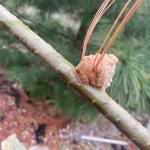
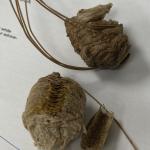 Mantid Ooetheca: The Mantidae (the family containing insects commonly known as praying mantises) are charismatic insects known for their abilities as predators of other insects. Mantids possess raptorial (grasping) forelegs which allow them to ambush and catch prey items that happen by. These hunters are fascinating to many observers to watch, and the impressive size of certain species can be intimidating to passersby. We have a few different species of mantids in Massachusetts and the eastern United States. The Chinese mantid (Tenodera sinensis) is very large, usually up to just over 4 inches in length, and is generally brown in color with green and yellow striping along the sides of the wings. It is typically considered the largest mantid species known to North America, but may be confused with the narrow-winged mantis (Tenodera angustipennis). Mantids develop from eggs that are laid in masses (an ootheca) which some have described as having a similar appearance to a packing peanut. Recently, mantid ootheca have been noticed by arborists and reported (3/21/2022) in Middlesex County, MA, including the egg masses pictured here. Immatures resemble the adults, but lack wings until the adult stage. The Chinese mantid was frequently sold as a predator of garden pests, however its ability to manage garden pests is thought to be overstated. These large and indiscriminant predators may also be seen capturing and eating beneficial insects such as bees, wasps, and other desirable species visiting flowers. As such, the purchase of mantids for the biological control of pest insects (especially smaller pests such as aphids, mites, and scales, which are not on the menu for mantids that prefer larger prey), is not typically recommended for gardeners. Additional mantid species found in the USA include the European mantid (Mantis religiosa), Carolina mantid (Stagmomantis carolina), California mantid (S. californica), and Florida mantid (S. floridensis). The Stagmomantis species are native.
Mantid Ooetheca: The Mantidae (the family containing insects commonly known as praying mantises) are charismatic insects known for their abilities as predators of other insects. Mantids possess raptorial (grasping) forelegs which allow them to ambush and catch prey items that happen by. These hunters are fascinating to many observers to watch, and the impressive size of certain species can be intimidating to passersby. We have a few different species of mantids in Massachusetts and the eastern United States. The Chinese mantid (Tenodera sinensis) is very large, usually up to just over 4 inches in length, and is generally brown in color with green and yellow striping along the sides of the wings. It is typically considered the largest mantid species known to North America, but may be confused with the narrow-winged mantis (Tenodera angustipennis). Mantids develop from eggs that are laid in masses (an ootheca) which some have described as having a similar appearance to a packing peanut. Recently, mantid ootheca have been noticed by arborists and reported (3/21/2022) in Middlesex County, MA, including the egg masses pictured here. Immatures resemble the adults, but lack wings until the adult stage. The Chinese mantid was frequently sold as a predator of garden pests, however its ability to manage garden pests is thought to be overstated. These large and indiscriminant predators may also be seen capturing and eating beneficial insects such as bees, wasps, and other desirable species visiting flowers. As such, the purchase of mantids for the biological control of pest insects (especially smaller pests such as aphids, mites, and scales, which are not on the menu for mantids that prefer larger prey), is not typically recommended for gardeners. Additional mantid species found in the USA include the European mantid (Mantis religiosa), Carolina mantid (Stagmomantis carolina), California mantid (S. californica), and Florida mantid (S. floridensis). The Stagmomantis species are native.
Insects and Other Arthropods
-
Deer Tick/Blacklegged Tick: Ixodes scapularis adults have been active all winter, as they typically are from October through May, and “quest” or search for hosts at any point when daytime temperatures are above freezing. Engorged females survive the winter and will lay 1,500+ eggs in the forest leaf litter beginning around Memorial Day (late May). For images of all deer tick life stages, along with an outline of the diseases they carry, visit: https://web.uri.edu/tickencounter/species/blacklegged-tick/ .
Anyone working in the yard and garden on springtime cleanup and planting should be aware that there is the potential to encounter deer ticks. The deer tick or blacklegged tick can transmit Lyme disease, human babesiosis, human anaplasmosis, and other diseases. Preventative activities, such as daily tick checks, wearing appropriate clothing, and permethrin treatments for clothing (according to label instructions) can aid in reducing the risk that a tick will become attached to your body. If a tick cannot attach and feed, it will not transmit disease. For more information about personal protective measures, visit: https://web.uri.edu/tickencounter/prevention/protect-yourself/ .
The Center for Agriculture, Food, and the Environment provides a list of potential tick identification and testing resources here: https://ag.umass.edu/resources/tick-testing-resources .
Woody ornamental insect and non-insect arthropod pests to consider, a selected few:
Invasive Insects & Other Organisms Update:
-
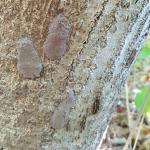 Spotted Lanternfly: (Lycorma delicatula, SLF) is a non-native, invasive insect that feeds on over 103 species of plants, including many trees and shrubs that are important in our landscapes. It overwinters as an egg mass, which the adult female insect lays on just about any flat surface. Pictures of egg masses can be seen here: https://massnrc.org/pests/linkeddocuments/SLFChecklistForResidents.pdf.
Spotted Lanternfly: (Lycorma delicatula, SLF) is a non-native, invasive insect that feeds on over 103 species of plants, including many trees and shrubs that are important in our landscapes. It overwinters as an egg mass, which the adult female insect lays on just about any flat surface. Pictures of egg masses can be seen here: https://massnrc.org/pests/linkeddocuments/SLFChecklistForResidents.pdf.
Currently, the only established populations of spotted lanternfly in Massachusetts are in a small area in both Fitchburg and Shrewsbury, MA. Therefore, there is no reason to be preemptively treating for this insect in other areas of Massachusetts. If you suspect you have found spotted lanternfly in additional locations, please report it immediately to MDAR here: https://massnrc.org/pests/slfreport.aspx . If you are living and working in the Fitchburg and Shrewsbury areas, please be vigilant and continue to report anything suspicious.
For More Information:
From UMass Extension:
Check out the InsectXaminer Episode about spotted lanternfly adults and egg masses! Available here: https://ag.umass.edu/landscape/education-events/insectxaminer
Fact Sheet: https://ag.umass.edu/landscape/fact-sheets/spotted-lanternfly
From the MA Department of Agricultural Resources:
Fact Sheet and Map of Locations in MA: https://massnrc.org/pests/pestFAQsheets/spottedlanternfly.html
-
Asian Longhorned Beetle: (Anoplophora glabripennis, ALB) Look for signs of an ALB infestation which include perfectly round exit holes (about the size of a dime), shallow oval or round scars in the bark where a female has chewed an egg site, or sawdust-like frass (excrement) on the ground nearby host trees or caught in between branches. Be advised that other, native insects may create perfectly round exit holes or sawdust-like frass, which can be confused with signs of ALB activity.
The regulated area for Asian longhorned beetle is 110 square miles encompassing Worcester, Shrewsbury, Boylston, West Boylston, and parts of Holden and Auburn. If you believe you have seen damage caused by this insect, such as exit holes or egg sites, on susceptible host trees like maple, please call the Asian Longhorned Beetle Eradication Program office in Worcester, MA at 508-852-8090 or toll free at 1-866-702-9938.
To report an Asian longhorned beetle find online or compare it to common insect look-alikes, visit: http://massnrc.org/pests/albreport.aspx or https://www.aphis.usda.gov/pests-diseases/alb/report .
-
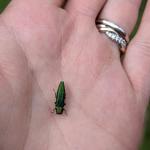 Emerald Ash Borer: (Agrilus planipennis, EAB) has been detected in at least 11 out of the 14 counties in Massachusetts. A map of these locations across the state may be found here: https://ag.umass.edu/fact-sheets/emerald-ash-borer . Additional information about this insect is provided by the MA Department of Conservation and Recreation, here: https://storymaps.arcgis.com/stories/b60f63199fa14805a8b9f7c82447a25b .
Emerald Ash Borer: (Agrilus planipennis, EAB) has been detected in at least 11 out of the 14 counties in Massachusetts. A map of these locations across the state may be found here: https://ag.umass.edu/fact-sheets/emerald-ash-borer . Additional information about this insect is provided by the MA Department of Conservation and Recreation, here: https://storymaps.arcgis.com/stories/b60f63199fa14805a8b9f7c82447a25b .
This wood-boring beetle readily attacks ash (Fraxinus spp.) including white, green, and black ash and has also been found developing in white fringe tree (Chionanthus virginicus) and has been reported in cultivated olive (Olea europaea). Signs of an EAB infested tree may include D-shaped exit holes in the bark (from adult emergence), “blonding” or lighter coloration of the ash bark from woodpecker feeding (chipping away of the bark as they search for larvae beneath), and serpentine galleries visible through splits in the bark, from larval feeding beneath. It is interesting to note that woodpeckers are capable of eating 30-95% of the emerald ash borer larvae found in a single tree (Murphy et al. 2018). Unfortunately, despite high predation rates, EAB populations continue to grow. However, there is hope that biological control efforts will eventually catch up with the emerald ash borer population and preserve some of our native ash tree species for the future. For an update about the progress of the biological control of emerald ash borer, visit Dr. Joseph Elkinton’s archived 2022 webinar now available here: https://ag.umass.edu/landscape/education-events/invasive-insect-webinars.
-
Spongy Moth: Lymantria dispar egg masses will be seen overwintering on just about any flat surface, including host plants such as oak, but also fencing, buildings, steps, outdoor furniture, and more. The end of winter and start of spring is a good time to scout properties, particularly in areas of Berkshire County, MA that experienced elevated L. dispar populations in 2021. If large numbers of egg masses are seen, plan to monitor them between 90-100 growing degree days (roughly the first week in May, but this varies) to better time egg hatch and caterpillar emergence. If egg masses are plentiful near high-value specimen trees in Berkshire County in 2022, consider applying the reduced risk insecticide Bacillus thuringiensis Kurstaki (Btk) to host plant leaves before caterpillars are over ¾ inch in length.
Why did the common name for Lymantria dispar change recently? More information is available here: https://entsoc.org/news/press-releases/spongy-moth-approved-new-common-name-lymantria-dispar .
-
Winter Moth: (Operophtera brumata) data since 2017 has indicated that the winter moth population in eastern Massachusetts has been on the decline while the percentage of winter moth pupae parasitized by Cyzenis albicans has increased! Dr. Joseph Elkinton’s laboratory at UMass Amherst has released this biological control of winter moth since 2005 and conducted the rigorous sampling required to determine where the insect has established and what its impact on the winter moth population has been at multiple sites in eastern MA. More information about the Elkinton Lab’s research and the biological control of winter moth can be found here: https://www.fs.fed.us/foresthealth/technology/pdfs/FHAAST-2018-03_Biology_Control_Winter-Moth.pdf
The take-home point? Do not worry about winter moth this spring! In fact, management of this insect in landscaped settings will likely not be necessary in most locations. Blueberry and apple growers may still, on the other hand, be interested in scouting and continuing to monitor for this insect, as only very low numbers of winter moth caterpillars might be tolerated in those systems. For an update about winter moth in blueberry and apple production from Heather Faubert, University of Rhode Island, visit: https://web.uri.edu/ipm/2022/03/winter-moth-update-3-18-22/
In recent years, it is worthwhile to note that some areas on the Cape and other locations in eastern MA have reported noticeable cankerworm populations in the spring, which are often confused for winter moth. Read more about cankerworms in the spring scouting list below.
-
Jumping Worms: Amynthas spp. earthworms, collectively referred to as “jumping or crazy or snake” worms, overwinter as eggs in tiny, mustard-seed sized cocoons found in the soil or other substrate (ex. compost). The tiny, impossible to remove cocoons will overwinter and provide a population of these earthworms in the 2022 season.
For More Information:
UMass Extension Fact Sheets:
- Earthworms in Massachusetts – History, Concerns, and Benefits: https://ag.umass.edu/landscape/fact-sheets/earthworms-in-massachusetts-history-concerns-benefits
- Jumping/Crazy/Snake Worms – Amynthas spp.: https://ag.umass.edu/landscape/fact-sheets/jumpingcrazysnake-worms-amynthas-spp
A Summary of the Information Shared at UMass Extension’s Jumping Worm Conference in January 2022: https://ag.umass.edu/news-events/highlights/jumping-worms-conference
Spring Scouting Suggestions & Preparation for Upcoming Tree & Shrub Insect Pests:
-
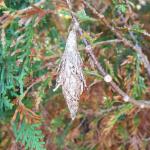 Bagworm: Thyridopteryx ephemeraeformis is a native species of moth whose larvae construct bag-like coverings over themselves with host plant leaves and twigs. This insect overwinters in the egg stage, within the bags of deceased females from last season. Eggs may hatch and young larvae are observed feeding around mid-June, or roughly between 600-900 GDD’s. Now is the time to scout for and remove and destroy overwintering bags. More information can be found here: https://ag.umass.edu/landscape/fact-sheets/bagworm
Bagworm: Thyridopteryx ephemeraeformis is a native species of moth whose larvae construct bag-like coverings over themselves with host plant leaves and twigs. This insect overwinters in the egg stage, within the bags of deceased females from last season. Eggs may hatch and young larvae are observed feeding around mid-June, or roughly between 600-900 GDD’s. Now is the time to scout for and remove and destroy overwintering bags. More information can be found here: https://ag.umass.edu/landscape/fact-sheets/bagworm
-
Balsam Twig Aphid: Mindarus abietinus overwinters as a silvery colored egg on host plant twigs. Eggs hatch just prior to budbreak and nymphs feed for a period of time on the undersides of last season’s needles before molting into a wingless stem mother. Stem mothers move to buds just as they open and give “live birth” to second generation nymphs. These second generation nymphs are the most damaging, feeding on new needles as they elongate, causing distortion and stunting. Excessive amounts of honeydew may be produced and cause needles to stick together. Foliar applications, if needed, may be made between 30-100 GDD’s, base 50°F on warm days before budcaps loosen. Inspect the twigs, near the base of needles of Balsam fir, Fraser fir, and other true firs for overwintering eggs and eventually the needles for feeding nymphs. This insect may be most problematic in Christmas tree production. In landscapes, many natural enemies can provide adequate management of this insect.
-
Boxwood Leafminer: Monarthropalpus flavus partly grown fly larvae overwinter in the leaves of susceptible boxwood. Yellowish mines may be noticeable on the undersides of leaves. This insect grows rapidly in the spring, transforming into an orange-colored pupa. After pupation, adults will emerge and white colored pupal cases may hang down from the underside of leaves where adults have emerged. Adults may be observed swarming hosts between 300-650 GDD’s, or roughly the end of May through June. Most cultivars of Buxus sempervirens and B. microphylla are thought to be susceptible. If installing new boxwoods this spring, resistant cultivars such as ‘Vardar Valley’ and ‘Handsworthiensis’ are good choices at sites where this insect has been a problem.
-
Boxwood Mite: Eurytetranychus buxi overwinter as tiny eggs on boxwood leaves and hatch mid-spring. These mites are tiny (about the size of a period) and difficult to detect. Feeding may cause plants to appear off-color. If management is deemed necessary, the timing for treatment may be between 245-600 GDD’s or roughly the beginning of May.
-
Boxwood Psyllid: Psylla buxi feeding can cause cupping of susceptible boxwood leaves. Leaf symptoms/damage may remain on plants for up to two years. English boxwood may be less severely impacted by this pest. Eggs overwinter, buried in budscales, and hatch around the budbreak of boxwood. Eggs may hatch around 80 GDD’s. While foliar applications may be made between 290-440 GDD’s, the damage caused by this insect is mostly aesthetic. Therefore, typically, management is not necessary.
-
Cankerworms: Alsophila pometaria (fall cankerworm) and Paleacrita vernata (spring cankerworm) are often confused for winter moth (Operophtera brumata). Cankerworm populations in eastern MA, particularly on areas of Cape Cod, were confused for winter moth in 2019. Spring cankerworm adults are active in February and March, and fall cankerworm adults are active in late November into early December. During these times, both species lay eggs. These native insects most commonly utilize elm, apple, oak, linden, and beech. Eggs of both species hatch as soon as buds begin to open in the spring. Caterpillars occur in mixed populations and are often noticeable by mid-May in MA. Young larvae will feed on buds and unfolding leaves. There are two color forms (light green and dark) for caterpillars of both species. Like winter moth, they will drop to the soil to pupate. This usually occurs in June. Fall cankerworm larvae have three pairs of prolegs (one of which is small so it is sometimes referred to as ½) and spring cankerworm have two pairs. (Winter moth caterpillars also have 2 pairs of prolegs.) If populations are large and damage is noticeable on hosts, reduced risk insecticides such as Bacillus thuringiensis Kurstaki or spinosad may target larvae between approximately 148-290 GDD’s.
-
Cooley Spruce Gall Adelgid: Adelges cooleyi is a native insect that has a complex life cycle. It has at least five different morphological forms, and requires 2 years and two hosts to complete its normal life cycle. Galls (pineapple shaped/cone-like and at the tips of twigs) are produced on Colorado blue spruce, Engelmann, Sitka, and Oriental spruce and cause needle injury (yellow spots and distortion) to Douglas-fir. Immature females overwinter on spruce near twig terminals. In the early spring, females mature into stem mothers and lay hundreds of eggs on lateral terminals. Upon egg hatch, nymphs migrate to new spring growth and feed at the base of growing needles. Immatures can be targeted on spruce between 22-81 GDD’s (mid-late April). On Douglas-fir, dormant oil applications should be made immediately before budbreak to avoid phytotoxicity. Follow all label instructions.
-
Eastern Spruce Gall Adelgid: Adelges abietis is a pest of Norway spruce primarily, but occasionally damages other spruce species such as Colorado blue, white, and red spruce. This adelgid overwinters as a partially grown female, often referred to as a stem mother. This overwintering individual matures around bud break and lays 100-200 eggs. The eastern spruce gall adelgid may be targeted for management between 22-170 GDD’s, base 50°F (mid-April to early-May). This insect is non-native, and was introduced into the United States from Europe before 1900. Galls are small, sometimes pineapple shaped/variable, but produced on the basal portion of the shoots, such that the twig extends beyond the gall. Twig dieback may occur.
-
Eastern Tent Caterpillar: Malacosoma americanum eggs overwinter on host plant twigs. Egg hatch typically occurs when wild cherry leaves begin to unfold and young caterpillars may emerge by late-April through the first two weeks in May (90-190 GDD’s). Susceptible hosts include cherry and crabapple. Other host plants whose leaves are fed upon by this native insect can include apple, ash, birch, willow, maple, oak, poplar, and witch-hazel. Prune off and remove egg masses from ornamental host plants by early spring. Eastern tent caterpillars are native to Massachusetts and have many associated natural enemies (parasites and predators) that help regulate populations. Unless these caterpillars are actively defoliating specimen trees in a landscaped setting, we can coexist with this particular herbivore native to our forests.
-
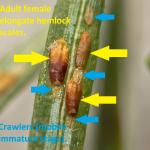 Elongate Hemlock Scale: Fiorinia externa is found on eastern, Carolina, and Japanese hemlock, as well as yew, spruce, and fir. The elongate hemlock scale may overwinter in various life stages, and overlap of many developmental stages at any given time can be observed throughout much of the season. Dormant oil applications for this pest can occur according to label instructions in April, roughly between 7-120 GDD’s. Treatments for the crawler, or mobile, stage of this insect may be made in late May through mid-June, or between 360-700 GDD’s, base 50°F. Nitrogen fertilizer applications may make elongate hemlock scale infestations worse.
Elongate Hemlock Scale: Fiorinia externa is found on eastern, Carolina, and Japanese hemlock, as well as yew, spruce, and fir. The elongate hemlock scale may overwinter in various life stages, and overlap of many developmental stages at any given time can be observed throughout much of the season. Dormant oil applications for this pest can occur according to label instructions in April, roughly between 7-120 GDD’s. Treatments for the crawler, or mobile, stage of this insect may be made in late May through mid-June, or between 360-700 GDD’s, base 50°F. Nitrogen fertilizer applications may make elongate hemlock scale infestations worse. -
Euonymus Scale: Unaspis euonymi is an armored scale that can be found on euonymus, holly, bittersweet, and pachysandra. This insect can cause yellow spotting on leaves, dieback, and distorted bark. Dormant oil applications can be made between 35-120 GDD’s or roughly from mid-April to early-May. For crawlers, early June timing is suggested between 533-820 GDD’s. (Eggs begin to hatch in early June.)
-
European Pine Sawfly: Neodiprion sertifer overwinters in the egg stage. Eggs are laid by females the previous season by cutting slits in needles using their ovipositors and depositing 6-8 eggs in each of 10-12 needles. Egg hatch occurs from late-April to mid-May and caterpillars become active roughly between 78-220 GDD, base 50°F. The primary host in MA is Mugo pine but it can be found on Scots, red, jack, and Japanese red pine. It is also found on white, Austrian, ponderosa, shortleaf, and pitch pine when planted near the aforementioned species. This dark colored caterpillar feeds in tight groups and small numbers can be pruned or plucked out of host plants and destroyed. Spinosad products can be used whenever the caterpillars are actively feeding, usually by mid-May and when caterpillars are still small. Bacillus thuringiensis kurstaki is not effective against sawflies.
-
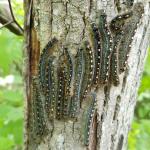 Forest Tent Caterpillar: Malacosoma disstria egg hatch occurs between 192-363 GDD’s, base 50°F, by mid-late May and caterpillars may be active for at least 5-6 weeks following. Susceptible hosts whose leaves are fed on by this insect include oak, birch, ash, maple, elm, poplar, and basswood. This native insect has many natural enemies, including some very effective pathogens that typically regulate populations. However, outbreaks of this insect can occur on occasion.
Forest Tent Caterpillar: Malacosoma disstria egg hatch occurs between 192-363 GDD’s, base 50°F, by mid-late May and caterpillars may be active for at least 5-6 weeks following. Susceptible hosts whose leaves are fed on by this insect include oak, birch, ash, maple, elm, poplar, and basswood. This native insect has many natural enemies, including some very effective pathogens that typically regulate populations. However, outbreaks of this insect can occur on occasion.
-
Hemlock Looper: Two species of geometrid moths in the genus Lambdina are native insects capable of defoliating eastern hemlock, balsam fir, and white spruce. Adult moths lay their eggs on the trunk and limbs of hosts in September and October, and eggs will hatch by late May or early June. (L. fiscellaria caterpillars may be active between 448-707 GDD’s.) Monitor susceptible hosts for small, inch-worm-like caterpillars. Where populations are low, no management is necessary. Hemlock loopers have several effective natural enemies.
-
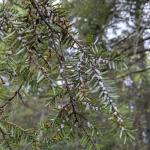 Hemlock Woolly Adelgid: Adelges tsugae is present on eastern and Carolina hemlock. The overwintering hemlock woolly adelgid generation (sistens) is present through mid-spring and produces the spring generation (progrediens) which will be present from early spring through mid-summer. HWA, unlike many other insects, does most of its feeding over the winter. Eggs may be found in woolly masses at the base of hemlock needles beginning in mid-March. Each woolly mass is created by a female who may then lay 50-300 eggs. Eggs hatch and crawlers may be found from mid-March through mid-July. Infested trees may be treated with foliar sprays in late April to early May, using Japanese quince as a phenological indicator. Systemic* applications may be made in the spring and fall, or when soil conditions are favorable for translocation to foliage. Nitrogen fertilizer applications may make hemlock woolly adelgid infestations worse.
Hemlock Woolly Adelgid: Adelges tsugae is present on eastern and Carolina hemlock. The overwintering hemlock woolly adelgid generation (sistens) is present through mid-spring and produces the spring generation (progrediens) which will be present from early spring through mid-summer. HWA, unlike many other insects, does most of its feeding over the winter. Eggs may be found in woolly masses at the base of hemlock needles beginning in mid-March. Each woolly mass is created by a female who may then lay 50-300 eggs. Eggs hatch and crawlers may be found from mid-March through mid-July. Infested trees may be treated with foliar sprays in late April to early May, using Japanese quince as a phenological indicator. Systemic* applications may be made in the spring and fall, or when soil conditions are favorable for translocation to foliage. Nitrogen fertilizer applications may make hemlock woolly adelgid infestations worse.
*Note: beginning July 1, 2022 systemic insecticides known as neonicotinoids (including imidacloprid) will become state restricted use for tree and shrub uses in Massachusetts. More information is available, here: https://www.mass.gov/service-details/pesticide-newsupdates
-
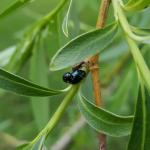 Imported Willow Leaf Beetle: Plagiodera versicolora adult beetles overwinter near susceptible hosts. Adult beetles will chew holes and notches in the leaves of willow once they become available. Females lay yellow eggs in clusters on the undersides of leaves. Larvae are slug-like and bluish-green in color. They will feed in clusters and skeletonize the leaves. Most plants can tolerate multiple years of feeding from this insect, and foliage will appear brown. Repeated yearly feeding can occasionally be an issue, in which case management of the young larvae may be necessary. Take care with treatment in areas near water.
Imported Willow Leaf Beetle: Plagiodera versicolora adult beetles overwinter near susceptible hosts. Adult beetles will chew holes and notches in the leaves of willow once they become available. Females lay yellow eggs in clusters on the undersides of leaves. Larvae are slug-like and bluish-green in color. They will feed in clusters and skeletonize the leaves. Most plants can tolerate multiple years of feeding from this insect, and foliage will appear brown. Repeated yearly feeding can occasionally be an issue, in which case management of the young larvae may be necessary. Take care with treatment in areas near water.
Check out Episode 4 of InsectXaminer to see the imported willow leaf beetle in action: https://ag.umass.edu/landscape/education-events/insectxaminer
-
Lecanium Scales (Oak): Parthenolecanium quercifex overwinters as a second instar nymph on oak twigs. Females will begin feeding and mature in the spring, from mid-April to early May and eggs may be laid between late May and into June. Eggs hatch in June or early July and crawlers migrate to host plant leaves where they spend the summer and migrate as second instars back to host plant twigs in the fall. Mid-April to early-May (35-145 GDD’s) for dormant oil applications.
-
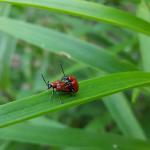 Lily Leaf Beetle: Lilioceris lilii adults overwinter in sheltered places. As soon as susceptible hosts such as Lilium spp. (Turk’s cap, tiger, Easter, Asiatic, and Oriental lilies) and Fritillaria spp. break through the ground, the adult lily leaf beetles are known to feed on the new foliage. (Note: daylilies are not hosts.) Typically, in May, mating will occur and each female will begin to lay 250-450 eggs in neat rows on the underside of the foliage. If there are only a few plants in the garden, hand picking and destroying overwintering adults can help reduce local garden-level populations at that time.
Lily Leaf Beetle: Lilioceris lilii adults overwinter in sheltered places. As soon as susceptible hosts such as Lilium spp. (Turk’s cap, tiger, Easter, Asiatic, and Oriental lilies) and Fritillaria spp. break through the ground, the adult lily leaf beetles are known to feed on the new foliage. (Note: daylilies are not hosts.) Typically, in May, mating will occur and each female will begin to lay 250-450 eggs in neat rows on the underside of the foliage. If there are only a few plants in the garden, hand picking and destroying overwintering adults can help reduce local garden-level populations at that time.
Check out Episode 3 of InsectXaminer to see the lily leaf beetle in action: https://ag.umass.edu/landscape/education-events/insectxaminer
-
Magnolia Scale: Neolecanium cornuparvum overwinters as first instar nymphs which are elliptical, and dark slate gray in color and can usually be found on the undersides of 1 and 2 year old twigs. Nymphs may molt by late April or May and again by early June at which time the scales may be purple in color. Eventually nymphs secrete a white powdery layer of wax over their bodies. Dormant oils can be applied between 7-35 GDD’s targeting the overwintering nymphs. Avoid applications to opening buds or blooms.
-
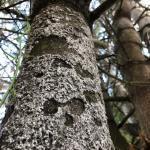 Pine Bark Adelgid: Pineus strobi overwinters as an immature which begins feeding during the first days of warm weather in the spring and begins secreting white wax over itself, which can eventually coat the entire trunk of infested trees. Egg laying may begin in April. This insect can be found on the trunk, branches, twigs, and the base of needles on new shoots. Spruce is a secondary host but this adelgid can repeatedly reproduce itself on pine. Wash off bark with a strong jet of water. If necessary, dormant oil applications can be made in mid-late April between 22-58 GDDs. Hosts include eastern white, Scots, and Austrian pines. This insect does little damage to healthy trees and can often be tolerated.
Pine Bark Adelgid: Pineus strobi overwinters as an immature which begins feeding during the first days of warm weather in the spring and begins secreting white wax over itself, which can eventually coat the entire trunk of infested trees. Egg laying may begin in April. This insect can be found on the trunk, branches, twigs, and the base of needles on new shoots. Spruce is a secondary host but this adelgid can repeatedly reproduce itself on pine. Wash off bark with a strong jet of water. If necessary, dormant oil applications can be made in mid-late April between 22-58 GDDs. Hosts include eastern white, Scots, and Austrian pines. This insect does little damage to healthy trees and can often be tolerated. -
Snowball Aphid: Neoceruraphis viburnicola eggs overwinter on viburnum twigs and buds. Eggs hatch and this aphid becomes active on certain species of viburnum roughly between 148-298 GDD’s or around redbud bloom. This insect is particularly noticeable on V. opulus, V. prunifolium, and V. acerifolia. Stem mothers, appearing blueish-white, can be found in curled up and distorted foliage. Damage caused by this insect pest is mostly aesthetic.
-
Spruce Bud Scale: Physokermes piceae is a pest of Alberta and Norway spruce, among others. Immatures overwinter on the undersides of spruce needles, dormant until late March. By April, females may move to twigs to complete the rest of their development. Dormant oil applications may be made between 22-121 GDDs. Follow all label instructions, as oil may remove the bluish color from certain conifers. Mature scales are reddish brown, globular, 3 mm. in diameter, and found in clusters of 3-8 at the base of new twig growth. They closely resemble buds and are often overlooked. Crawlers are present around June.
-
Spruce Spider Mite: Oligonychus ununguis is a cool-season mite that becomes active in the spring from tiny eggs that have overwintered on host plants. Hosts include spruce, arborvitae, juniper, hemlock, pine, Douglas-fir, and occasionally other conifers. This particular species becomes active in the spring and can feed, develop, and reproduce through roughly June. When hot, dry summer conditions begin, this spider mite will enter a summer-time dormant period (aestivation) until cooler temperatures return in the fall. This particular mite may prefer older needles to newer ones for food. When damaging spruce spider mite populations are known from last season, dormant oil applications can be made (when temperatures are appropriate according to label instructions) between 7-121 GDD’s, base 50°F (April). Magnification is required to view spruce spider mite eggs. Tapping host plant branches over white paper may be a useful tool when scouting for spider mite presence. (View with a hand lens.) Spider mite damage may appear on host plant needles as yellow stippling and occasionally fine silk webbing is visible. Be sure to also scout for predatory mite adults and eggs which can help regulate spruce spider mite populations. Avoid broad spectrum chemical management options that kill predatory mite populations, often making spruce spider mite outbreaks worse.
-
Viburnum Leaf Beetle: Pyrrhalta viburni is a beetle in the family Chrysomelidae that is native to Europe, but was found in Massachusetts in 2004. Viburnum leaf beetle overwinters as eggs laid in capped pits on the newest growth of susceptible viburnum branches. Scout for overwintered eggs and prune out and destroy before they hatch. Egg hatch occurs in late-April to early-May as temperatures warm and foliage becomes available. Monitor for larvae in mid-May (80-120 GDD’s). This beetle feeds exclusively on many different species of viburnum, which includes, but is not limited to, susceptible plants such as V. dentatum, V. nudum, V. opulus, V. propinquum, and V. rafinesquianum. Some viburnum have been observed to have varying levels of resistance to this insect, including but not limited to V. bodnantense, V. carlesii, V. davidii, V. plicatum, V. rhytidophyllum, V. setigerum, and V. sieboldii. More information about viburnum leaf beetle may be found at http://www.hort.cornell.edu/vlb/ .
-
White Pine Weevil: Pissodes strobi adults overwinter in sheltered locations in the leaf litter and become active very early in the spring, when daytime temperatures reach 50°F and before the bloom of forsythia (between 7-58 GDDs). Hosts include eastern white pine, Norway spruce, scotch, pitch, and red pine, blue spruce, and white spruce. Adults will begin feeding on bark 7-10 inches below dormant terminal buds. Females will deposit eggs in terminal growth bark, and developing larvae will feed in leaders until they mature in July when pupation occurs in pupal chambers made of wood chips. Management in nurseries or Christmas tree production may be necessary. Target adults between 7-58 GDD’s.
-
Woolly Apple Aphid: Eriosoma lanigerum may be found on apple, crabapple, hawthorn, mountain-ash, Pyracantha, and elm hosts. The primary (winter) host is elm, on which aphids infest emerging spring leaves, causing leaves to curl or close into stunted, rosette-like clusters found at twig tips. On apple and crabapple, this species of aphid colonizes roots, trunks, and branches in the summer and is commonly found near previous wounds or callous tissue. On roots, the aphids cause swelled areas which can girdle and kill roots. The aphids, when found in above ground plant parts such as elm leaves, are covered with white wax. Eggs are the overwintering stage on elm, which hatch in the spring in time for the nymphs to infest new elm foliage. Following a few generations on elm, the aphids will develop into a winged form, which will disperse and seek out apple and crabapple. Multiple generations will occur on these alternate hosts in the summer and by the fall, a winged form will return to elm and mated females will lay eggs near elm buds. These aphids are a favorite snack for insect predators such as the multicolored Asian lady beetle, Harmonia axyridis. Elm can withstand multiple years of woolly apple aphid infestation and this insect is primarily aesthetic in its impact to trees. Management may not be necessary.
-
Woolly Elm Aphid: Eriosoma americanum females lay a single egg in the cracks and crevices of elm bark, where the egg overwinters. Eggs hatch on elm in the spring as leaves are unfolding. Aphids may be active from 121-246 GDD’s, base 50°F on elm. A young, wingless female hatched from the egg feeds on the underside of leaf tissue. This female aphid matures and gives birth to 200 young, all females, without mating. These aphids feed, and the elm leaf curls around them and protects them. By the end of June, winged migrants mature and find serviceberry hosts. Another set of females is produced. These new females crawl to and begin feeding on the roots of serviceberry. Multiple generations occur on the roots of serviceberry through the summer. Elm can withstand multiple years of woolly elm aphid infestation and this insect is primarily aesthetic in its impact to trees. Management may not be necessary. Lady beetle larvae and adults often feed on these insects.
Concerned that you may have found an invasive insect or suspicious damage caused by one? Need to report a pest sighting? If so, please visit the Massachusetts Introduced Pests Outreach Project: http://massnrc.org/pests/pestreports.htm .
Reported by Tawny Simisky, Extension Entomologist, UMass Extension Landscape, Nursery, & Urban Forestry Program
Landscape Turf
Cultural Practices
The UMass Turf Program’s own Dr. Scott Ebdon this week delivered a great lecture on water management and water conservation… a highlight from our 2022 Spring Kickoff education program. When attention turns to conserving water in turf management, some ponder why water conservation deserves much bandwidth in the generally cool, humid Northeast region.
In the big picture, water is a finite natural resource, and conserving it is a mainstay of responsible management. Despite higher average annual precipitation rates relative to some other regions of the country, there is a trend in the Northeast for increasing frequency of drought events. This, coupled with population growth, means that water not used for drinking or food production is often the first to be limited when water restrictions are implemented.
On a management-level scale, the meteorological summer months of June, July, and August (also sometimes referred to as the “irrigation season”) comprise the most stressful period for the cool-season grasses that are otherwise well-adapted to this region. While water can be a vital tool for turf survival and meeting stakeholder expectations, greater water use also frequently equates to greater expense. Fortunately, decades of objective research have refined practices designed to promote increased turf performance while simultaneously conserving water.
To paraphrase Dr. Ebdon from the aforementioned lecture: it seems out of place to be thinking about water conservation this early in the game, especially coming off of the record-bending rainfall totals that many regional locations received in 2021. Turns out that while a lot of turf is just beginning to show signs of life, a well-rounded, effective approach to optimizing water use begins at the very start of the growing season. Much of the equation concerns rooting: roots are central to moisture acquisition, drought avoidance responses, and overall plant resiliency, which places rooting among the most important aspects of water management.
Spring is when cool-season grasses produce most of their annual root mass. Root capacity also slides under the high soil temperatures of summer; therefore spring is prime time to have root development high on the priority list. The following are some management considerations to promote better rooting, and by extension, water conservation:
Turfgrass selection: Grasses better adapted to the growing environment will have greater overall health and vigor, which translates to greater rooting. There is also variation in inherent rooting capacity among turfgrass species and varieties; grasses with a genetic propensity for better rooting will capture moisture more readily and exhibit higher drought avoidance characteristics. Take stock of what you’re working with now: if the grasses present are a less than great fit for the setting, consider planning for overseeding, renovation or reconstruction with better adapted species and varieties in late summer.
Soil Conditions:
-
Test soil and employ proper liming practices. pH values approaching 5.0 and lower can restrict both root growth and root activity. pH in the neutral range also maximizes mineral nutrient availability, especially essential micronutrients.
-
Regular aeration supports rooting in several ways including better water infiltration, better gas exchange with the atmosphere, and relief from excessive thatch and soil compaction. Aeration is a disruptive practice, however, and should be performed only when adequate conditions for recovery exist, typically in late summer. Aeration and other cultivation activities performed in the spring can bring weed seeds to the surface during the time of maximum annual weed pressure, and can potentially affect the performance of any prior preemergence weed control applications.
Mowing: Particularly during the favorable period in the spring, mow if possible at the high end of the appropriate range for the species and use of the turf, as rooting depth and density are roughly proportional to mowing height. Cutting too low, or too frequently, shrinks leaf area which translates into reduced photosynthetic capacity, and less photosynthetic capacity can support less root mass and depth.
Fertility: Use measured fertility matched to the individual circumstances and time maximum nutrient availability to correspond with peak growth periods.
-
Too much available nitrogen can result in excessive vegetative (shoot) growth which occurs at the expense of root growth. High nitrogen rates may yield vibrant green color and vigorous growth in the short term, but these benefits are typically unsustainable due to negative impact on the root system over the longer term.
-
Phosphorus is essential for new tissue development, especially root tissue. Test soil to determine needs for supplemental P, if any (excessive P rates can contribute to water pollution).
Watering: It may seem counter-intuitive at first, but deep, infrequent irrigation is much preferred to frequent, shallow irrigation. Irrigating often, and in short bursts, only serves to wet the soil to a shallow depth. Allowing the soil to dry down between irrigation events helps to condition plants and stimulates root expansion, thereby promoting a deeper and more extensive root system and greater overall resiliency. Consider a wilt-based irrigation approach to build plant resiliency throughout the season
Pesticides, especially herbicides: Some herbicides can affect the roots of desirable turfgrasses, especially preemergence herbicides when used at high rates or when turf is not fully mature. Employing practices within a weed management program to minimize the use of herbicides can help to promote root vigor. Be sure to time herbicide applications accurately, avoid applying outside of the proper weather conditions as specified on the product label, and avoid blanket applications in favor of spot applications whenever possible.
Submitted by Jason Lanier, Extension Turf Specialist, UMass Extension's Agriculture & Commercial Horticulture Program
Additional Resources
Pesticide License Exams - The MA Dept. of Agricultural Resources (MDAR) is now holding exams online. For more information and how to register, go to: https://www.mass.gov/pesticide-examination-and-licensing.
To receive immediate notification when the next Landscape Message update is posted, join our e-mail list or follow us on Facebook.
For a complete listing of upcoming events, see our upcoming educational events https://ag.umass.edu/landscape/upcoming-events
For commercial growers of greenhouse crops and flowers - Check out UMass Extension's Greenhouse Update website
For professional turf managers - Check out Turf Management Updates
For home gardeners and garden retailers - Check out our home lawn and garden resources.
Diagnostic Services
UMass Laboratory Diagnoses Landscape and Turf Problems - The UMass Extension Plant Diagnostic Lab is available to serve commercial landscape contractors, turf managers, arborists, nurseries and other green industry professionals. It provides woody plant and turf disease analysis, woody plant and turf insect identification, turfgrass identification, weed identification, and offers a report of pest management strategies that are research based, economically sound and environmentally appropriate for the situation. Accurate diagnosis for a turf or landscape problem can often eliminate or reduce the need for pesticide use. For sampling procedures, detailed submission instructions and a list of fees, see Plant Diagnostic Laboratory
Soil and Plant Nutrient Testing - The University of Massachusetts Soil and Plant Nutrient Testing Laboratory is located on the campus of The University of Massachusetts at Amherst. Testing services are available to all. The lab provides test results and recommendations that lead to the wise and economical use of soils and soil amendments. For more information, including current turn-around times, visit the UMass Soil and Plant Nutrient Testing Laboratory web site. The lab is currently accepting new orders for Routine Soil Analysis (including optional Organic Matter, Soluble Salts, and Nitrate testing), Particle Size Analysis, Pre-Sidedress Nitrate (PSNT), and Soilless Media (no other types of soil analyses available at this time). Turnaround time: Please plan for the fact that date of receipt in the lab is affected by weekends, holidays, shipping time, and time for UMass Campus Mail to deliver samples to the lab.
Tick Testing - The UMass Center for Agriculture, Food, and the Environment provides a list of potential tick identification and testing options at: https://ag.umass.edu/resources/tick-testing-resources.
Acknowledgements: UMass Extension gratefully acknowledges the support of the following funding sources for the production of the Landscape Message –
- The Massachusetts Nursery and Landscape Association Fund
- The Massachusetts Department of Conservation and Recreation, Award #ISADCR28219926UMA22A
- Stakeholders like you! The Landscape Message is partially supported by educational program user fees.